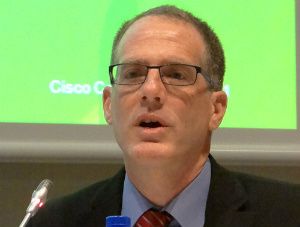Cisco Systems’ acquisition of network optimisation vendor Intucell closed just three days before the start of this week’s Mobile World Congress, great timing for a deal that is likely to play a big role in Cisco’s mobile future.
Intucell makes software that can automatically modify a mobile network in real time based on how it’s currently performing. By taking steps such as reducing the footprint of a heavily used cell, Intucell’s system can increase average throughput on the network by about 12%, according to Rani Wellingstein, co-founder and CEO (pictured). He spoke at a Cisco press event on Tuesday morning at MWC, an appearance made possible when Cisco’s $475 million buyout received final approval on Friday.
The startup’s SON (self-optimising network) technology makes up a major piece of Cisco’s plan to supply mobile networks that better serve subscribers and help carriers make money. The venerable wireline and Wi-Fi vendor is introducing its first stand-alone small cell this week, and though it doesn’t plan to build large ‘macro’ cells like those that dominate today’s cellular networks, it essentially wants to be the company that makes mobile run.
The press event highlighted two service providers that are using Cisco smarts to offer new types of services: Cricket, the US mobile operator selling downloadable songs with its Muve Music service, and Shaw Communications, a Canadian cable operator offering its subscribers mobile service via Cisco Wi-Fi hotspots.
Cisco says it can bring to bear components and software all across a carrier’s infrastructure from the RAN (radio access network) to the core, where it already has a major presence. The tools to make that happen are incorporated in Cisco Quantum, a software platform that’s also making its debut this week.
Quantum can take real time data about network conditions, applications in use and customer profiles, analyse it to draw out useful information, and act on those insights based on carrier policies. For example, if a cellular network’s performance is falling short for a ‘high value’ customer, such as an executive trying to do a videoconference on a mobile device, Quantum could automatically shift that user to a nearby Wi-Fi network. Real time data about nearby networks and the customer’s priority would dictate that decision, according to Shailesh Shukla, general manager and vice president of Cisco’s software applications group.
Cisco’s aim is one being echoed throughout MWC, that of squeezing the most performance out of a mobile operator’s network, when and where it matters most to the carrier and subscriber. Intucell should help to make that possible.
For example, at the last Super Bowl, Intucell technology changed a service provider’s policies for specific users and specific applications on the fly to deal with heavy mobile data traffic, Wellingstein said.
"We adjusted the policy on the fly to accelerate the bandwidth on specific applications which are more bandwidth sensitive and prioritised such applications," Wellingstein said. The company’s technology is in use on several large networks around the world, he said.
This ability to tune the network on the fly will help carriers change their RANs over time from traditional networks dominated by big macro cells on towers and roofs to a complicated mix of macro cells, small cells and Wi-Fi access points, Wellingstein said.
That transformation may present Cisco’s best opportunity to become a much bigger player in cellular. One barrier to the company making further inroads into cellular RANs is co-ordination with macro cells, because small cells can interfere with macros when they use the same frequencies in the same area.
Some observers have questioned whether Cisco can make its RAN gear coordinate with current macro cells. Intucell is also Cisco’s answer to that problem, said Kelly Ahuja, senior vice president and general manager of Cisco’s service provider mobility group. Intucell’s software is already coordinating with macro cells in commercial networks, he said.
IDG News Service







Subscribers 0
Fans 0
Followers 0
Followers